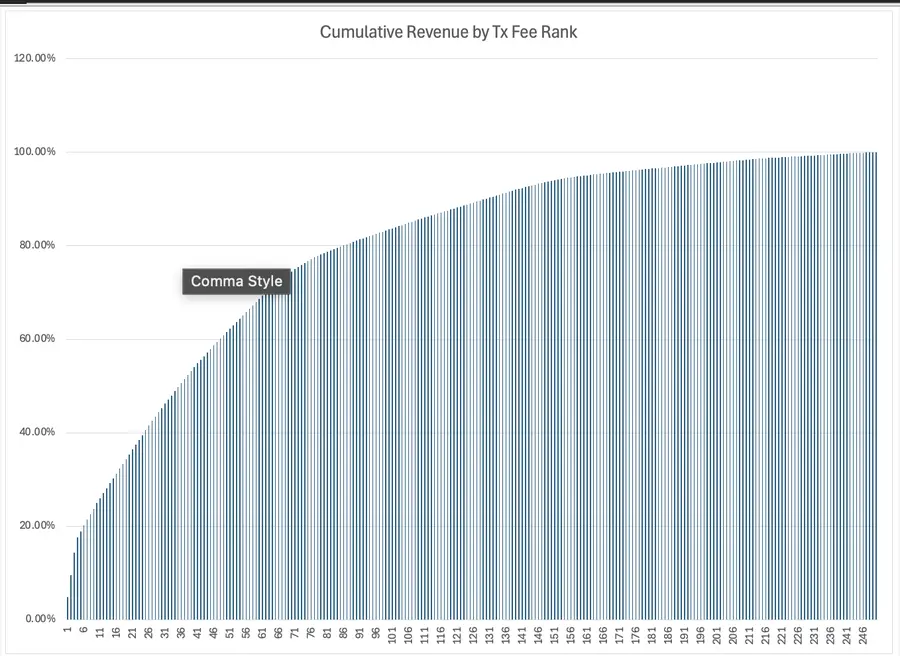Ethereum Scaling Economic Account: Is it Worth Giving the Bulk of Sorting Revenue to L2?
Source: Doug Colkitt X account
Author: Doug Colkitt
Compiled by: Shenchao TechFlow
This is a great analysis of Data Availability (DA), and the most reasonable speculation about DA in a bull market. However, I believe DA cannot approach 50% of L2 fees. From an economic structure perspective, the value accumulation of sorting always far exceeds that of DA.

The core business of blockchain is selling block space. Since block space is difficult to interchange between different chains, they almost form a monopoly.
However, not all monopolies can achieve excess profits. The key lies in whether price discrimination can be applied to consumers.
If price discrimination cannot be applied, monopoly profits are almost indistinguishable from ordinary goods. Think about how airlines differentiate between price-insensitive business travelers and budget-conscious regular consumers, or how the same SUV is sold at vastly different prices under the Volkswagen, Audi, and Lamborghini brands.
Priority fees are an extremely effective price discrimination mechanism in blockchain. Transactions with the highest priority pay fees that far exceed the median.

L2 and Solana achieve price discrimination by leveraging the priority of sorters, resulting in high throughput and high revenue. The fees paid for marginal transactions are very low, supporting high TPS, while price-insensitive transactions pay most of the network revenue.
Here is the transaction distribution from 5 randomly selected blocks from Base L2. This presents a clear Pareto distribution, making price discrimination extremely effective. The top 10% of transactions paid 30% of the revenue, while the bottom 10% paid less than 1%.

The problem is that while sorters can profit from this, the DA layer cannot participate because it lacks the ability for price discrimination. Whether it's high-value arbitrage transactions or 1 wei junk transactions, the fees paid on Ethereum DA are the same because they settle in the same batch.
Since the value of marginal transactions is very low, high TPS can only be achieved when median transactions can be on-chain at near-zero cost. However, at the DA layer, essentially every transaction pays the same fee. The DA layer can either have high throughput or high revenue, but cannot have both simultaneously.
This makes it nearly impossible for rollups to scale without impacting Ethereum's network revenue. A rollup-centric roadmap is fundamentally flawed because it abandons the valuable part of the network (sorting), mistakenly believing it can be compensated by the worthless part (DA).
I was initially optimistic about a rollup-centric roadmap because I believed rational people would recognize the economics of price discrimination and that it could develop in parallel with L1 scaling.
High-value and price-insensitive users would choose L1 because it offers permanence, security, and finality, while L2 focuses on those marginal low-price users excluded due to high L1 fees. Thus, Ethereum could still gain considerable sorter rent.
However, Ethereum's leadership has repeatedly emphasized that L1 as an application layer is no longer important and will not scale. As a result, users and developers have made rational responses, leading to a gradual decline of the L1 application ecosystem, while Ethereum's network revenue is also decreasing.

If you believe the long-term value of ETH lies in being a currency asset, then this may still be feasible. By getting more people to hold ETH, it can become a form of currency with permanence. Subsidizing L2 without accumulating value at the base layer may promote this.
But if you believe the long-term value of ETH lies in being a network stake within a widely used protocol (which I think is more likely than ETH as a currency), then value accumulation needs to be achieved. Clearly, we have made mistakes at this point due to erroneous economic assumptions.









